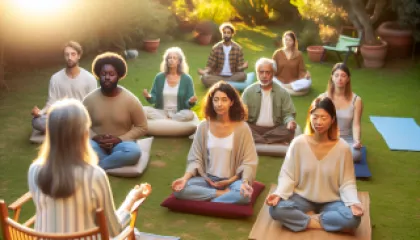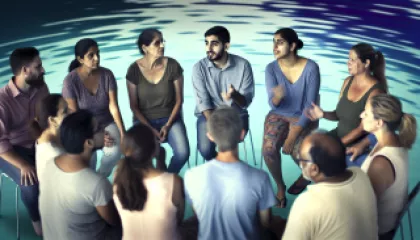Why Transition Guidance Services Are Crucial for Personal Growth
Why Transition Guidance Services Are Crucial for Personal Growth
Navigating the complexities of life's transitions can be a daunting task, but with the right support, individuals can emerge from these pivotal moments stronger, wiser, and more resilient than ever before. In this opinion piece, Quincy Bell explores the profound impact that transition guidance services can have on personal growth, and why they are an essential resource for anyone facing significant changes in their life.
The Inevitability of Transition
Change is a constant in our lives, and the transitions that come with it can be both exhilarating and overwhelming. Whether it's a career shift, a relationship change, a relocation, or a major life event, the process of adapting to new circumstances can be deeply challenging. Many people find themselves struggling to cope with the uncertainty, the emotional upheaval, and the practical demands that accompany these transitional periods.
Yet, it is precisely during these times of transition that we have the greatest opportunity for personal growth and transformation. As David Perry eloquently states, "Transition is not just a moment of change – it is a gateway to self-discovery and the cultivation of new possibilities." By embracing the challenges and embracing the inherent growth potential of these periods, individuals can emerge from them with a deeper understanding of themselves, a renewed sense of purpose, and a stronger foundation for navigating the road ahead.
The Power of Transition Guidance Services
This is where transition guidance services come into play. These specialized resources, offered by trained professionals, provide a comprehensive framework for navigating the complexities of life's transitions. From career changes to relationship challenges, from personal crises to major life events, transition guidance services offer a comprehensive and tailored approach to help individuals navigate these pivotal moments with greater ease and resilience.
At the heart of these services is a deep understanding of the psychological, emotional, and practical aspects of transition. Trained professionals work closely with clients to help them explore their fears, their aspirations, and their unique strengths and weaknesses. Through a combination of counseling, coaching, and practical support, they guide individuals through the process of adaptation, helping them to develop the skills, mindsets, and strategies necessary to thrive in the face of change.
The Transformative Power of Transition Guidance
The benefits of transition guidance services extend far beyond the immediate challenges of a particular transition. By providing a structured and supportive framework for personal growth, these services can have a profound and lasting impact on an individual's overall well-being and sense of purpose.
For Aubrie Butler, a recent client of a transition guidance program, the experience was nothing short of life-changing. "When I found myself facing a major career shift, I was overwhelmed and uncertain about the path forward," she recalls. "But working with my transition coach, I was able to uncover my true passions, develop a clear plan of action, and ultimately make a successful transition that has left me feeling more fulfilled and empowered than ever before."
Similarly, Aviana Nelson, who utilized transition guidance services after the end of a long-term relationship, shares, "The support and guidance I received during that difficult time helped me to process my emotions, rebuild my self-confidence, and ultimately emerge from the experience with a deeper understanding of who I am and what I truly want in life. It was a transformative journey that has continued to shape my personal growth long after the transition itself."
The Holistic Approach to Transition Management
One of the key strengths of transition guidance services is their holistic approach to supporting individuals through periods of change. Rather than focusing solely on the practical aspects of a transition, these services address the emotional, psychological, and even spiritual dimensions of the experience.
This holistic approach recognizes that transitions are not just about external circumstances, but about the internal journey of self-discovery and personal transformation. By addressing the multifaceted nature of transition, transition guidance services can help individuals develop a more comprehensive and resilient approach to managing change.
As David Perry explains, "Transition is not just about finding a new job or a new relationship – it's about rediscovering your core values, reconnecting with your authentic self, and cultivating the mindsets and skills that will allow you to thrive in the face of ongoing change. Transition guidance services provide the crucial support and resources needed to navigate this profound journey of personal growth."
The Importance of Personalized Support
Every individual's experience of transition is unique, and transition guidance services recognize this by offering personalized support tailored to the specific needs and circumstances of each client. Whether it's navigating a career change, adjusting to a new life stage, or overcoming a personal crisis, these services ensure that individuals receive the customized attention and guidance they need to navigate their transition successfully.
For Quincy Bell, this personalized approach was key to their transformative experience with transition guidance services. "I had tried to manage my transition on my own, but I kept hitting roadblocks and feeling overwhelmed," they share. "Working with my transition coach, I was able to develop a tailored plan that addressed my specific challenges and strengths. The support and accountability they provided were instrumental in helping me overcome my obstacles and emerge from the transition feeling more resilient and empowered than ever before."
The Lasting Impact of Transition Guidance
The true power of transition guidance services lies in their ability to create lasting, transformative change. By equipping individuals with the tools, skills, and mindsets necessary to navigate periods of transition, these services don't just help people get through a particular challenge – they help them develop a robust and adaptable approach to managing change throughout their lives.
As Aviana Nelson reflects, "The lessons I learned through my transition guidance experience have continued to serve me well long after the initial transition was over. I've been able to apply the strategies and insights I gained to navigate subsequent changes in my life with greater ease and confidence. It's an investment in my personal growth that continues to pay dividends."
Embracing the Transformative Potential of Transition
In conclusion, transition guidance services are a crucial resource for anyone facing significant changes in their life. By providing a comprehensive and personalized approach to managing the complexities of transition, these services empower individuals to embrace the inherent growth potential of these pivotal moments, and to emerge from them stronger, wiser, and more resilient than ever before.
As David Perry so eloquently states, "Transition is not something to be feared, but to be embraced. It is a gateway to self-discovery, a chance to cultivate new possibilities, and an opportunity to forge a path that aligns with our deepest values and aspirations. With the right support and guidance, we can navigate these moments of change with grace, courage, and a renewed sense of purpose."
For those facing a major transition in their lives, the investment in transition guidance services may just be the most profound and transformative step they can take. By embracing the power of these resources, they can unlock a world of personal growth, resilience, and fulfillment – a journey that promises to enrich every aspect of their lives, now and for years to come.
In this opinion piece, we have explored the crucial role that transition guidance services play in supporting personal growth and resilience. From the inevitability of transition to the transformative power of personalized support, these specialized resources offer a comprehensive framework for navigating the complexities of life's pivotal moments.
By addressing the emotional, psychological, and practical aspects of transition, transition guidance services empower individuals to embrace change, cultivate new possibilities, and emerge from these experiences with a deeper understanding of themselves and a renewed sense of purpose. The lasting impact of these services extends far beyond the initial transition, equipping people with the tools and mindsets necessary to navigate ongoing change with greater ease and confidence.
As we navigate the ever-evolving landscape of our lives, the importance of transition guidance services cannot be overstated. They are a crucial resource for personal growth, resilience, and the cultivation of a fulfilling, adaptable, and purposeful path forward. By embracing the transformative potential of these services, individuals can unlock a world of possibilities and embark on a journey of self-discovery that promises to enrich every aspect of their lives.






